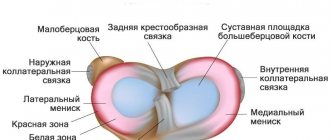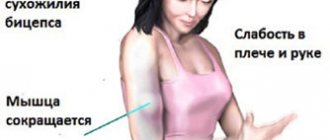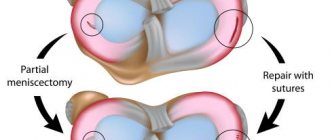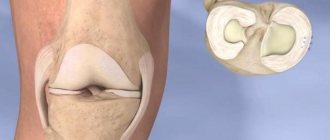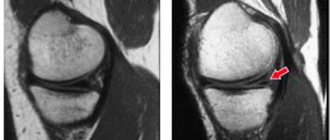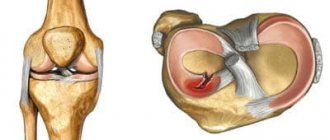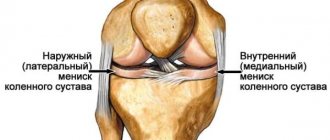The meniscus is a layer of cartilage tissue that performs a shock-absorbing function and gives stability to the joint.
The knee joint has an outer (lateral) and inner (medial) meniscus. Meniscus injuries are of the following nature:
- separation of the meniscus from the place of fixation in the areas of the anterior and posterior horns, as well as the body of the meniscus in the paracapsular zone;
- rupture of the anterior and posterior horns, the body of the meniscus in the transchondral area;
- various combinations of the injuries described above;
- excessive mobility of the meniscus due to degenerative processes or ligament ruptures;
- chronic trauma, including meniscal degeneration and cystic degeneration of the lateral meniscus.
By their nature, the tears are incomplete, complete, longitudinal (like a “watering can handle”), transverse, crushed, patch-like.
Each requires a special approach, and the price of meniscus surgery varies depending on the situation.
How is meniscus removal surgery performed?
Surgery performed to remove the meniscus of the knee joint is called meniscectomy.
It is used for serious injuries, which include a torn meniscus.
Previously, a technique was used for this purpose that involved opening the knee joint - open meniscectomy.
Today it is considered outdated and doctors have practically abandoned its use.
Open meniscectomy has been replaced by a new minimally invasive surgical technique for removing the meniscus of the knee joint - arthroscopy.
Its advantages:
- does not require large incisions on the skin;
- minimal trauma;
- low risk of postoperative complications;
- the ability to study the condition of the joint cavity on the monitor during the operation.
What is an arthroscope?
The device consists of three tubes. At the end of the first tube there is a light source and a micro-video camera that displays the image on the monitor.
Through the second tube of the arthroscope, a special sterile liquid is injected into the joint cavity, and the third tube is a guide for the instruments.
Arthroscopy involves making three skin incisions to alternately insert each of the three arthroscope tubes.
The size of the incisions does not exceed half a centimeter. During the operation, fluid is injected to expand the intervention area. The sterile liquid also makes the work of the trauma surgeon easier.
Small tears are then sutured and the meniscus is excised as with the open meniscectomy technique.
Upon completion of the necessary manipulations, the arthroscope is removed and the fluid is removed from the joint. Then the incisions are sutured and a sterile bandage is applied.
Meniscus injuries
Menisci are layers of cartilage that are located inside the knee joint and primarily perform shock-absorbing and stabilizing functions. There are two menisci in the knee joint: medial (internal) and lateral (external).
The following meniscus injuries are distinguished:
- Separation of the meniscus from the attachment site in the area of the anterior and posterior horns and the body of the meniscus in the paracapsular zone;
- Tears of the anterior and posterior horns and the body of the meniscus in the transchondral zone;
- Various combination of the first two damages;
- Increased mobility of the menisci (meniscus degeneration, ligament rupture);
- Chronic trauma, as well as meniscal degeneration, cystic degeneration of the external meniscus.
A meniscus tear can be complete, incomplete, longitudinal (also called “watering can handle”), transverse, flap-like, or fragmented.
Video - arthroscopy of the knee joint
Advantages of meniscus removal surgery in Israeli clinics
Carrying out such an operation with us will help restore the motor function of the knee one hundred percent.
Thanks to timely treatment, the patient does not face serious consequences in the form of inflammation, limited joint mobility and lameness.
Knee arthroscopy in Israeli medical institutions is today recognized as the “gold standard”.
When carrying out such treatment for meniscal tears, an outpatient regimen is quite sufficient.
Damage to the meniscus is typical for people involved in professional sports. A meniscus tear often occurs due to sudden rotation of the joint.
Arthroscopic surgery is performed to remove torn tissue and preserve the element of cartilage that managed to survive.
If timely surgical intervention is not taken care of, the cartilage tissue may continue to tear, and the smooth articular cartilage risks being damaged.
This will lead not only to increased pain, but also to the development of arthritis (that is, inflammation of the knee joint).
Causes and types of injuries leading to meniscus removal
Meniscus injuries lead to emergency surgery:
- meniscal rupture of varying degrees of complexity, accompanied by severe pain;
- joint locking or tearing of part of the meniscus.
Removal of the meniscus is a radical measure for injury with tissue rupture over 50%. This surgical intervention is due to the fact that such injuries do not heal on their own and are accompanied by limited mobility of the knee.
Meniscectomy is the removal of a meniscus damaged with several types of tears:
- complete fragmentation;
- in the form of shreds;
- tearing off part of the cartilage.
Removing the meniscus is not always an adequate response to injury. Minor damage to the knee meniscus and bruises are usually treated until complete recovery.
Types of arthroscopic surgeries associated with meniscal tears
The operation to remove the meniscus can be performed using different technologies.
The specific technique is chosen by the attending physician, who is guided by the individual characteristics of the patient’s body, the nature and degree of damage, the age and weight of the patient.
If we are talking about surgical intervention, then the type of operation is determined by the location and degree of damage, and the operation itself consists of removal of the meniscus (meniscectomy), its plastic surgery and replantation of cartilage tissue.
Our clinic prefers the method of plastic meniscus restoration.
These operations are recognized as the most effective, since the percentage of postoperative complications is minimal.
The suturing of torn sections of cartilage tissue is carried out using bioabsorbable threads; it is possible to fasten them with special medical darts.
The risk of infection during minimally invasive operations is minimized.
Blood loss during such operations is small, there are no postoperative scars.
Treatment of menisci without removal
Treatment of the meniscus begins after diagnosing the extent of the damage. Magnetic resonance imaging can detect even those injuries in the joint that an x-ray cannot detect.
Once a meniscus tear surgical intervention is performed. Due to the fact that the process of destruction of articular cartilage has already begun after the injury, the operation is performed in a short time in order to localize and eliminate the damage.
The decision to stitch the meniscus is made by the doctor. For this purpose, bioabsorbable threads are used. Such treatment of injury is preferable promptly, as opposed to advanced ruptures, when there is nothing more to save.
Why is it better to perform meniscus removal surgery with us?
Arthroscopy of the knee joints in our clinic is carried out as planned, so the doctor sets the date of the operation based on the client’s wishes.
It is extremely important not to delay and to carry out the operation no later than two months after the injury.
In our country, arthroscopy is trusted only to qualified orthopedic surgeons who have repeatedly and successfully dealt with the most complex meniscus injuries.
The operation program includes work to study damage to cartilage tissue and its restoration.
At this stage, a few punctures are enough to introduce endoscopic instruments and an arthroscope equipped with special lighting equipment and a compact video camera into the joint cavity.
The image is magnified 40 to 60 times, and the surgeon can observe the internal structures of the joint on a monitor.
Thanks to this, surgery on cartilage tissue can be carried out even with microscopic damage.
Our clinic uses spinal anesthesia, in which the patient's lower body is immobilized.
What are the types of meniscal injuries?
In 75% of cases of knee injuries, tears of the meniscus of the knee joint are diagnosed. Depending on the origin, there are several types of meniscus tears.
Meniscus injuries . The menisci can be damaged as a result of a direct or combined blow to the knee joint. In such cases, the shin rotates, which damages the meniscus. Typically injuries occur as a result of:
• deep squats with weights, including when the athlete squats for a long time in the bottom position; • jumping on hard or uneven surfaces; • long walks in single file; • falls on a bent leg; • direct physical blows to the knee joint. Separately, there are chronic lesions that occur with frequent injuries and are found in professional athletes.
The causes of damage may be careless movements, prolonged exposure to an uncomfortable position, or other stress on the cartilage pad. At a young age, such injuries usually occur as a result of professional and amateur sports - volleyball, basketball, badminton, running, gymnastics, wrestling. The meniscus is not designed to withstand such loads; in professional athletes, it can withstand them only by strengthening the muscular-ligamentous apparatus. However, when the impact is decompensated (for example, unsuccessful eversion), it injures the meniscus with the same effect in both trained and untrained people.
Degenerative ruptures . This type of injury is caused by degenerative changes in the knee joint. They are caused by: • chronic diseases – arthritis, arthrosis; • gout; • age-related degeneration of cartilage tissue; • repeated microtraumas.
At risk are athletes, people over 50 years of age and people with chronic diseases. In athletes, damage to the meniscus of the knee joint most often occurs during training. Constant microtraumas disrupt circulation in the affected area, and as a result, any overstrain leads to injury. This is especially often observed among roller skaters, football players, figure skaters, basketball players, skiers, and dancers. Damage to the lateral meniscus can cause a quick turn, a poor landing, or a sudden sudden strain.
After 50 years, approximately 20% of women and more than 30% of men experience dystrophic changes in the menisci of the knee joint. Over the age of 70 – every second person. This is due to the fact that with age, cartilage tissue becomes thinner, so the likelihood of damage to the meniscus of the knee joint increases. The same problem applies to people with chronic diseases. Pathological changes in the menisci of the knee joint can be caused by excess weight, gout, arthrosis, and rheumatism. Diseases lead to tissue swelling, thinning of collagen fibers and cause inflammatory processes. Ruptures are the most common damage. However, they are rarely isolated: in most cases, meniscal tears also affect other structures - ligaments, muscles, tendons, cartilage. They can be:
Full . The joint becomes immobilized due to the fact that the gap between the tendons and the joint capsule sharply narrows. Any attempt to move the leg causes sharp pain in the knee joint. Partial . They are asymptomatic or accompanied by dull pain, swelling, and decreased mobility in the joint.
In addition, tears are classified according to other criteria: which meniscus is affected (internal or external), by the location of the damage (body, anterior or posterior horn, complex) and shape (flap, “watering can handle” and others). Osteopathy looks at the whole body as a whole, so we consider any problems with the menisci of the knee joint as a failure in the entire system. Therefore, in addition to the above reasons (trauma, degenerative disorders), we are always looking for others. For example, a malfunction in the general biomechanics of the body leads to overloads in the menisci and the entire joint. Thus, curvature of the spine can cause skeletal asymmetry and uneven loads on the menisci.
Scoliosis leads to a misalignment of the hip joint, so one leg is lower than the other. A difference in position of even 1 cm causes increased stress and, therefore, permanent microtrauma in the menisci.
Rehabilitation after surgery
When the surgery to remove the meniscus is completed, the patient is kept in the recovery room for about two hours.
After this time, if there are no consequences, you can leave the medical facility.
Arthropathy of the knee joints is extremely rarely accompanied by pain and other discomfort.
To prevent the patient from developing postoperative syndrome, he is prescribed painkillers for three days.
To relieve swelling and reduce postoperative pain, the patient is given cold compresses and an articulated bandage to the knee joint to hold the leg in the desired position.
The patient's behavior after surgery must comply with the recommendations of the attending physician.
Keeping the limb elevated helps promote faster healing.
After one or two days, depending on the degree of damage, the patient can already get up. Such a competent and carefully thought-out approach to treatment allows for complete restoration of joint functions.
After operations related to meniscus injuries, temporary immobilization of the joint is prescribed.
After this, the patient must engage in rehabilitation activities. Physical therapy, physiotherapeutic procedures, exercises on special joint simulators, which help achieve a gradual increase in loads and range of motion.
Some time after the operation, the patient will be able to return to a normal, full-fledged life and sports activities.
Treatment
Treatment can be surgical or conservative. The choice of technique depends on the degree of damage, which was determined during ultrasound or MRI. Conservative therapy involves puncture of the joints (pumping out fluid to reduce swelling and pain), taking medications (NSAIDs and painkillers) and limiting exercise.
Indications for surgical intervention are separation of the body and horns of the cartilaginous plate, displaced ruptures, crushing of the plate and insufficient effectiveness of conservative treatment.
Types of operations: • Stitching of the plate. A suture can be applied in case of separation from the capsule, peripheral and longitudinal vertical damage. A prerequisite is the absence of degenerative changes. • Meniscectomy (complete or partial removal of the cartilage pad). This radical intervention is indicated for large avulsions or degeneration of cartilage tissue. These measures are not always safe and effective. Thus, most methods of conservative treatment (pumping out fluid, painkillers) are only temporary measures that relieve pain for a short time.
Surgery, especially meniscectomy after meniscus tears, is dangerous due to complications such as effusions, arthritis and arthrosis. Therefore, without an integrated approach, good results in knee joint restoration cannot be achieved.
Rehabilitation plan after meniscus removal surgery
After surgery to remove the meniscus, it is necessary through rehabilitation to return the knee joints to the full range of motion in combination with strengthening the muscles in the lower extremities.
The standard rehabilitation plan includes wearing a brace for six weeks and a set of exercises that do not include weight bearing.
Over the next month and a half, a gradually increasing load on the operated limb is allowed in combination with other exercises.
After three months of rehabilitation, you can move on to light impact loads in combination with exercises.
It is not allowed to lift both legs off the ground at the same time. After 16 weeks, any physical activity is allowed.
For professional athletes there is a set of special exercises, but only under the supervision of a doctor.
